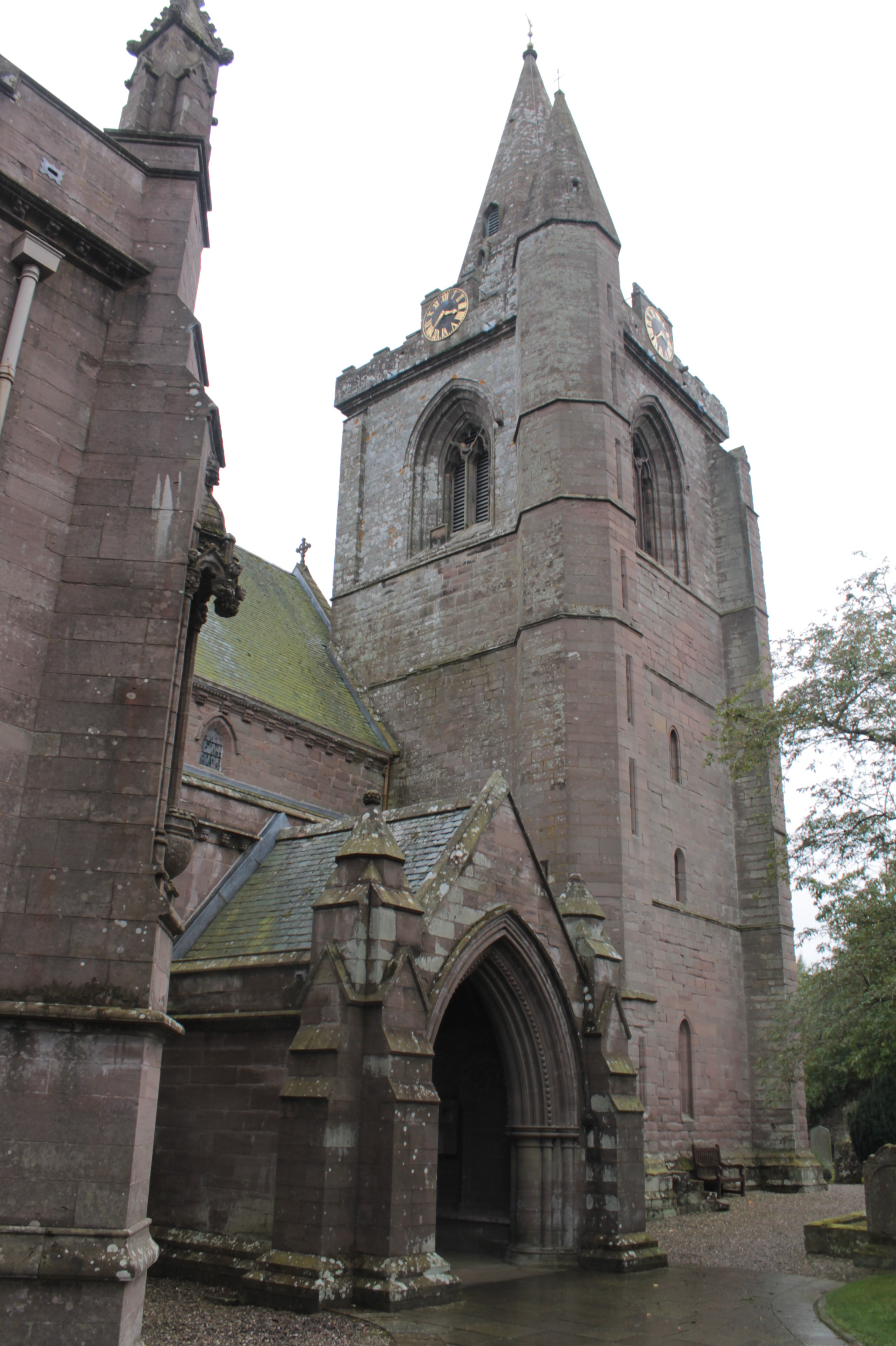|
Brechin Cathedral
Brechin Cathedral dates from the 13th century. As a congregation of the Church of Scotland, which is Presbyterian, the church is not technically a cathedral, in spite of its name. It is in the Pointed style, but suffered maltreatment in 1806 at the hands of restorers, whose work was subsequently removed during the restoration completed in 1902. The western gable with its flamboyant window, Gothic door and massive square tower, parts of the (much truncated) choir, and the nave pillars and clerestory are all that is left of the original edifice. The modern stained glass in the chancel is reckoned amongst the finest in Scotland. The cathedral is a category A listed building and the attached Round Tower is a scheduled monument. Round Tower Immediately adjoining the cathedral to the southwest stands the Round Tower, built about A.D. 1000. It is 86 ft.(26.21 m) high, has at the base a circumference of 50 ft.(15.3 m) and a diameter of 16 ft.(4.9 m), and is capped with a ... [...More Info...] [...Related Items...] OR: [Wikipedia] [Google] [Baidu] |
Scotland
Scotland (, ) is a country that is part of the United Kingdom. Covering the northern third of the island of Great Britain, mainland Scotland has a border with England to the southeast and is otherwise surrounded by the Atlantic Ocean to the north and west, the North Sea to the northeast and east, and the Irish Sea to the south. It also contains more than 790 islands, principally in the archipelagos of the Hebrides and the Northern Isles. Most of the population, including the capital Edinburgh, is concentrated in the Central Belt—the plain between the Scottish Highlands and the Southern Uplands—in the Scottish Lowlands. Scotland is divided into 32 administrative subdivisions or local authorities, known as council areas. Glasgow City is the largest council area in terms of population, with Highland being the largest in terms of area. Limited self-governing power, covering matters such as education, social services and roads and transportation, is devolved from the Scott ... [...More Info...] [...Related Items...] OR: [Wikipedia] [Google] [Baidu] |
Abernethy, Perth And Kinross
Abernethy ( gd, Obar Neithich) is a village in Perth and Kinross, Scotland, situated south-east of Perth. Etymology Abernethy, recorded in the 10th century as ''Aburnethige'', means 'mouth of the river Nethy'. The first element of the name is the Pictish word ''aber'' 'river mouth'. The river-name Nethy is from the Celtic root ''nect''- 'pure, clean'. The Nethy Burn flows down from the Ochil Hills past the present village. The Gaelic form of the name is Obar Neithich and derives from the same roots as the English name. History The village was once the "capital" (or at least a major religious and political centre) of the kingdom of the Picts. The parish church, which sits on land given by Nechtan, king of the Picts, is dedicated to Saint Brigid of Kildare of ( fl. 451–525), and the church is said to have been founded by Dairlugdach, second abbess of Kildare, one of early Christian Ireland's major monasteries. Abernethy was the site of the Treaty of Abernethy in 1072 between ... [...More Info...] [...Related Items...] OR: [Wikipedia] [Google] [Baidu] |
Cathedrals Of The Church Of Scotland
A cathedral is a church (building), church that contains the ''cathedra'' () of a bishop, thus serving as the central church of a diocese, Annual conferences within Methodism, conference, or episcopate. Churches with the function of "cathedral" are usually specific to those Christian denominations with an episcopal hierarchy, such as the Catholic Church, Catholic, Eastern Orthodox Church, Eastern Orthodox, Anglicanism, Anglican, and some Lutheranism, Lutheran churches.New Standard Encyclopedia, 1998 by Standard Educational Corporation, Chicago, Illinois; page B-262c Church buildings embodying the functions of a cathedral first appeared in Italy, Gaul, Spain, and North Africa in the 4th century, but cathedrals did not become universal within the Western Catholic Church until the 12th century, by which time they had developed architectural forms, institutional structures, and legal identities distinct from parish churches, monastery, monastic churches, and episcopal residences. Th ... [...More Info...] [...Related Items...] OR: [Wikipedia] [Google] [Baidu] |
Medieval Cathedrals In Scotland
In the history of Europe, the Middle Ages or medieval period lasted approximately from the late 5th to the late 15th centuries, similar to the post-classical period of global history. It began with the fall of the Western Roman Empire and transitioned into the Renaissance and the Age of Discovery. The Middle Ages is the middle period of the three traditional divisions of Western history: classical antiquity, the medieval period, and the modern period. The medieval period is itself subdivided into the Early, High, and Late Middle Ages. Population decline, counterurbanisation, the collapse of centralized authority, invasions, and mass migrations of tribes, which had begun in late antiquity, continued into the Early Middle Ages. The large-scale movements of the Migration Period, including various Germanic peoples, formed new kingdoms in what remained of the Western Roman Empire. In the 7th century, North Africa and the Middle East—most recently part of the Eastern Roman ... [...More Info...] [...Related Items...] OR: [Wikipedia] [Google] [Baidu] |



